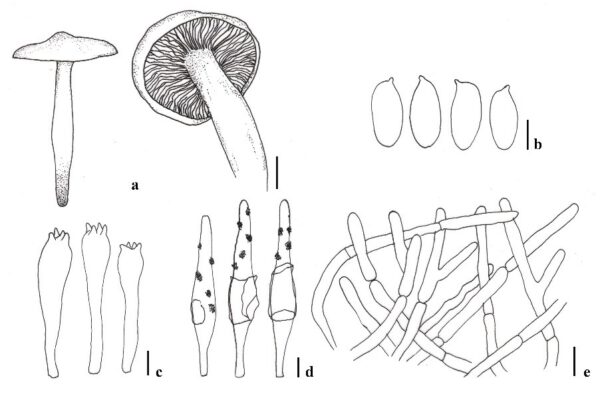Fungalpedia – Note 147 Gomphidius
Gomphidius Fr.
Citation if using this entry: Bera et al. (in prep) – Fungalpedia, Basidiomycota 1. Mycosphere.
Index Fungorum, MycoBank, Facesoffungi, GenBank, Fig. 1
Gomphidiaceae, Boletales, Agaricomycetes, Basidiomycota, Fungi
The type genus of the family Gomphidiaceae was originally designated as Agaricus subgen. Gomphus Fr. but later, Fries (1825) raised it to the generic level and renamed it as Gomphidius. However, Fries did not initially designate a type species for the genus, but later, Gomphidius glutinosus (Schaeff.) Fr. was designated as the lectotype because it was the first species listed (Miller Jr 1971). The name “Gomphidius,” is derived from the Greek word “gomphos,” which means ‘large wedge-shaped nail’ or ‘plug,’ reflecting the shape of its basidiomata. As described by Singer (1949) and Miller Jr (1971), the genus is characterized by its glutinous, glabrous to tomentose or fibrillose surface and variedly coloured pileus which sometimes turns dark and blackish on maturity and bruising with a lamellate hymenophore. The lamellae attachment is generally decurrent with obtuse edges and somewhat gelatinous in nature (Singer 1949). The context of the pileus is whitish to pale pinkish while the stipe’s context has yellowish tinges towards the end (Miller Jr 1971). The stipe of the members of Gomphidius is mostly glutinous but moist above the annulus and is mostly whitish or pinkish with yellow to dark yellow or sometimes purplish black towards the basal part (Miller Jr 1971). The blackening with maturity is also observed in the stipe. The veil if present is usually glutinous-hyaline or cortinoid and becomes fugacious with age (Singer 1949, Miller Jr 1971). The spore prints are always brownish to blackish comprising the ellipsoid to fusoid, inamyloid, and thin- to thick-walled basidiospores (Singer 1949, Miller Jr 1971). Cystidia can be present in both the edge and side of the lamellae and are often hyaline with thin or thick walls (Miller Jr 1971). Clamp connections are observed in Gomphidius (Miller Jr 1971). Gomphidius species are typically mycorrhizal. They are often found in association with Picea, Pinus, or Larix (Singer 1949, Miller 1963, McNabb 1970). While some Gomphidius species are considered edible (G. oregonensis Peck, G. glutinosus), many are not commonly consumed due to their strong, often bitter taste. The classification of Gomphidius has undergone revisions and refinements by various mycologists over time. Singer (1949) initially classified Gomphidius into three subgenera: Chroogomphus, Myxogomphus and Laricogomphus. Later, Miller Jr (1971) then recognized three sections of Gomphidius, sect. Gomphidius, sect. Roseogomphus O.K. Miller and sect. Microsporus Sing. Molecular studies based on nrITS sequence data have been initiated by Miller et al. (2002). Currently as per Species Fungorum 2023 (https://www.speciesfungorum.org/) 16 species of Gomphidius are documented.
Synonyms: Agaricus subgen. Gomphus Fr., Gomphus (Fr.) Weinm., Leucogomphidius Kotl. & Pouzar
Type species: Gomphidius glutinosus (Schaeff.) Fr.
Other accepted species: Refer Species Fungorum (https://www.speciesfungorum.org/)
Figure 1. Gomphidius albipes (HMJAU34328, holotype). a. Basidiomata. b. Basidiospores. c. Basidia. d. Abhymenial hairs. d. Pleurocystidia and cheilocystidia with encrustations. e. Pileipellis. Clamp connections of hyphae. Scale bars: b = 15 μm, c = 10 μm, d = 5 μm. Drawn from Qi et al. 2017.
References
Fries EM 1825 – Systema Orbis Vegetabilis. Primas lineas novæ constructionis periclitatur EF Pars I. Plantæ Homonemeæ.
McNabb RFR 1970 – A record of Gomphidius maculatus (Agaricales) in New Zealand. New Zealand Journal of Botany, 8(3), 320–325.
Miller Jr OK 1963 – The Gomphidiaceae, a monograph of the genera and species and their world distribution. Ph.D. dissertation, Rackham School of Graduate Study, University of Michigan, 136 p.
Miller Jr OK 1971 – The genus Gomphidius with a revised description of the Gomphidiaceae and a key to the genera. Mycologia, 63(6), 1129–1163.
Miller Jr OK, Aime MC, Camacho FJ, Peintner U 2002 – Two new species of Gomphidius from the western United States and eastern Siberia. Mycologia, 94(6), 1044–1050.
Qi LL, Fu YP, Lang N, Bai XJ, Li Y 2017 – A new species of Gomphidius from northeast China. Phytotaxa, 316(2), 181–188.
Singer R 1949 – The genus Gomphidius Fries in North America. Mycologia, 41(4), 462–489.
Entry by
Ishika Bera, Center of Excellence in Fungal Research, Mae Fah Luang University, Chiang Rai 57100, Thailand
(Edited by Kevin D Hyde)
Published online 3 October 2023
